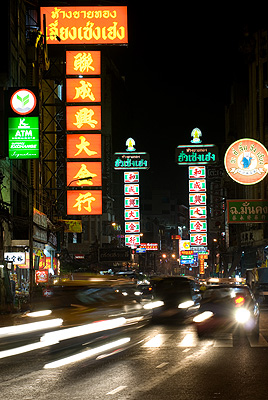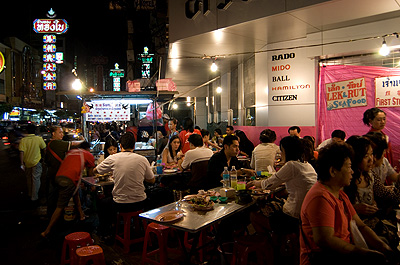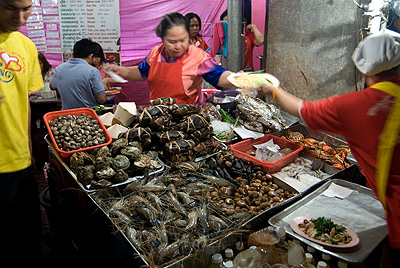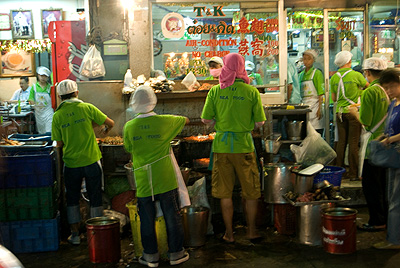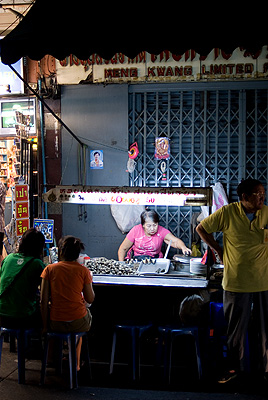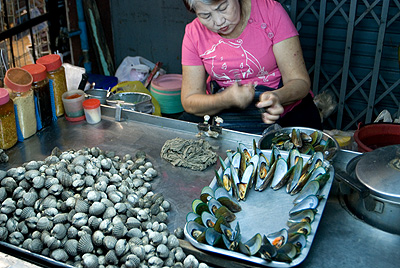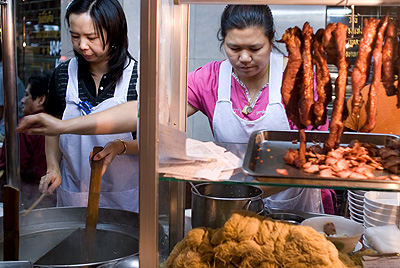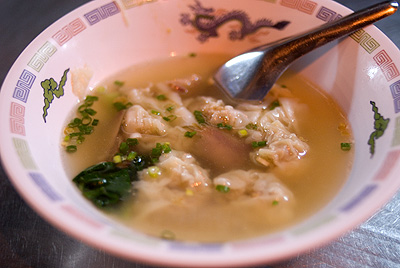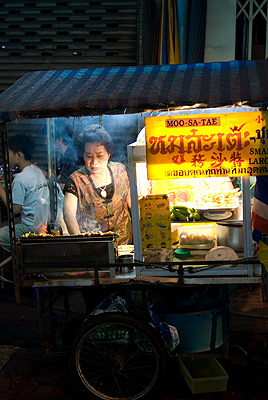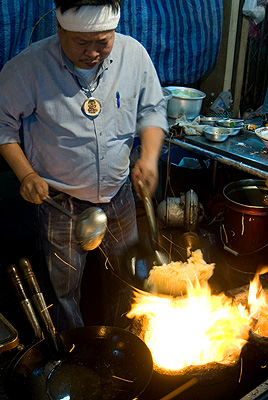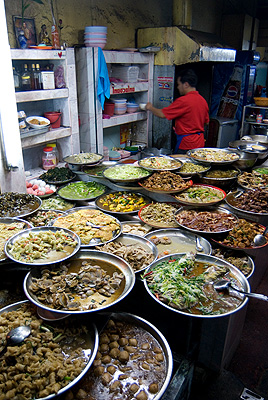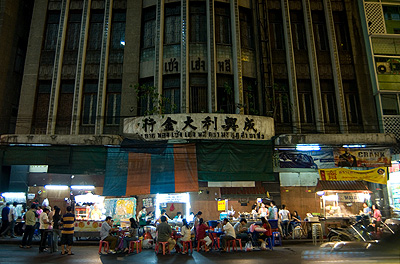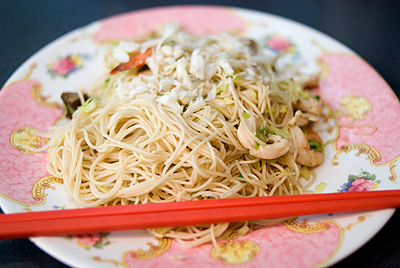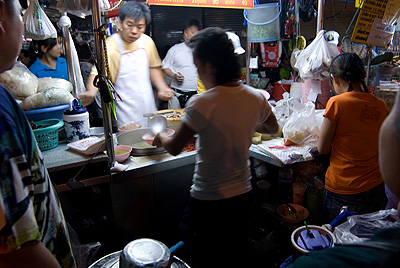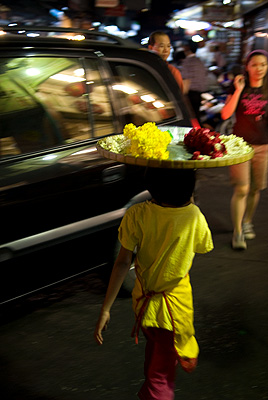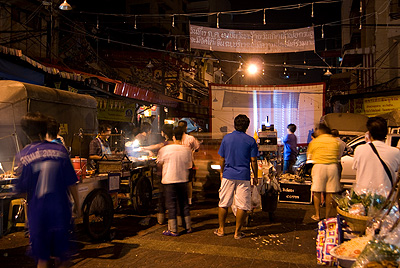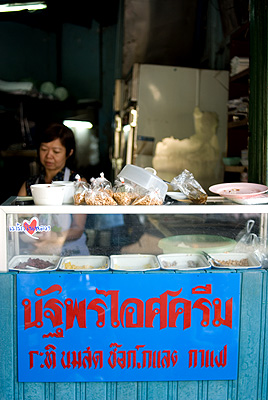
The article below was written by friend and journalist Hal Lipper, and ran in last Sunday's The Nation. I was along with Hal, David and Phi Tong and took the pics that accompanied the article.
This is how David Thompson does it. The world's only Michelin-star chef specialising in Thai cuisine spends days with grey-haired grannies in the kitchen, watching them pound pastes and stir curries.
He takes copious notes while they cook and when sampling their food, and then later recreates and enhances their traditional dishes in Nahm, his restaurant in the Halkin Hotel in London.
Thompson, who currently is in Thailand to supervise photography for his book on Thai street food, took The Nation on a road trip to Sing Buri to search for some of the region’s best fare.
In 36 hours, we ate nearly two dozen Central Plains dishes – ranging from curries to grilled snakehead fish to stir-fried frog, wild boar and cobra – and made a 4am foray to Sing Buri’s sprawling wholesale market.

Singburi's morning market.
“The food in the central plains is more rustic, more fully flavoured and sweeter than Bangkok,” noted Thompson, whose first cookbook “Thai Food” culled forgotten recipes from funerary texts that had been written to commemorate exemplary chefs.
We sampled the cobra, wild boar and frog at the Look Thung restaurant – which shares its name with the country-music style. It’s an open-air affair on a dusty road just outside the provincial capital of Ang Thong. It had been recommended by a friend of chef Tanongsak “Dtong” Yordwai, Thompson’s partner of two decades. The reptiles and amphibians are chopped and dried before being stir-fried with a chilli paste, and are primarily drinking foods – good with beer or rice whisky, but not worth the three-hour drive from Bangkok.

A stir fry of cobra, Look Thung Restaurant, Ang Thong.
Sing Buri is known for its snakehead fish, which Thompson feels is the finest in Thailand. Among the best restaurants to sample this huge, primal-looking fish is Mae Laa Paa Pao (Mae La Grilled Snakefish) just outside Sing Buri on Route 1.
The snakeheads here are grilled over coconut husks until their skin is black and crispy and can be peeled off to reveal the toothsome, naturally oily flesh. The smoky aroma and delicate flavour are astounding.

Poo lon, a dish of crab and pork simmered in coconut cream and herbs, Sum Phai Restaurant, Singburi.
We sampled a half dozen other dishes, but none compared with the grilled snakehead.
The highlight of the trip was Sum Phai (Bamboo Grove) Restaurant, a rustic, al fresco eatery set at the end of an irrigation canal about 10 kilometres past Ampur Muang in Sing Buri’s Hua Paa district. (The restaurant, closed by the recent floods, will reopen after January 1.)
Sum Phai was a remarkable find. Its chefs – three related by blood, the fourth related by marriage – together have nearly two centuries’ culinary experience. The eldest chef’s mother and grandmother were cooks, and their recipes are from the days of King Rama V, who used to visit Sing Buri, celebrated for its superb produce, fish and local cuisine.

Deep frying semi-dried snakehead fish, Sum Phai restaurant, Singburi.
All dishes at Sum Phai are cooked using local ingredients, including herbs and chillies plucked from a garden that grows beside the kitchen. The women here pride themselves on their frog salad and frog jungle curry. But amphibians were in short order that day, so they instead made plaa raa sap, fermented fish minced with fresh herbs.
Also on the menu: kaeng bon, a thick curry made from grilled fish, coconut milk and tamarind, kaeng khee lek, a coconut cream-based curry made with fish, a lemongrass salad with cashews, deep-fried snakehead fish, poo lon, a dish of crab and pork simmered in coconut cream, a stir-fry of morning glory and shrimp, and luk tan, the fruit of the palm-sugar tree, for dessert.
Thompson positioned himself on a stool in the corner of the kitchen and took copious notes. Dtong helped the chefs prepare collect the ingredients.

David Thompson grinding a curry paste, Sum Phai Restaurant, Singburi.
The people of the central plains generally use fresh, indigenous ingredients rather than frozen foods from other provinces. “Food here is prepared and cooked in context with local society. It’s cooked with great care,” Thompson noted.
Two hours later, just before plating, Thompson and Dtong were shooed to the dining area, which is shaded with palm fronds and flowering vines.

Tanongsak “Dtong” Yordwai, David Thompson and Hal Lipper enjoy a meal at Sum Phai Restaurant, Singburi.
The dishes rolled from the kitchen. The kaeng bon was rich with taro and the bitter-sour leaves in the kaeng kee lek were a nice counterpoint to the sweet coconut cream, tamarind and savoury grilled beef.
Thompson was ecstatic. “You rarely get raw fish dips or taro shoot dishes in Bangkok,” he noted.
The lemongrass salad was made with fresh shrimp rather than dried prawns. Thompson liked it so much that he said he would cook a variation with squid and roasted coconut for William Paterson, Australia’s ambassador to Thailand, at a dinner for 30 the next week.

A "yam" or salad of thinly-sliced lemongrass and deep-fried dried prawns, Sum Phai restaurant, Singburi.
“In the countryside, you find better, fresher ingredients, and more authentic flavour,” Thompson noted. “The techniques may not be as refined as in Bangkok, but the results are often superior.”
Hal Lipper
The Nation
 technorati tags: thai, food, singburi, david, thompson
technorati tags: thai, food, singburi, david, thompson












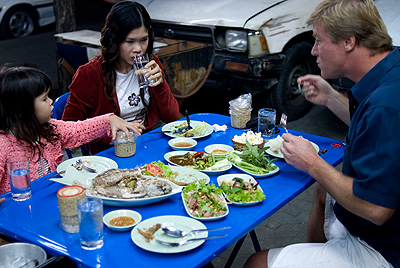
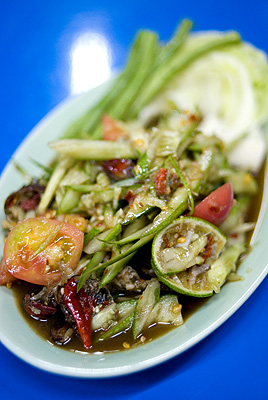
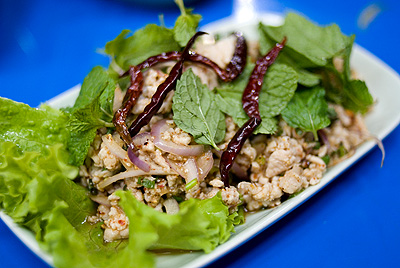
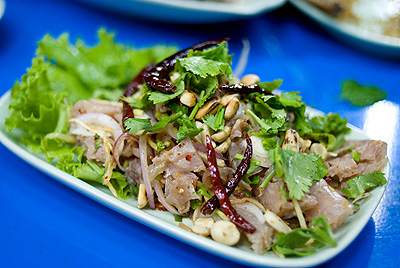
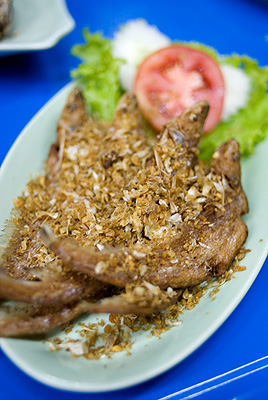
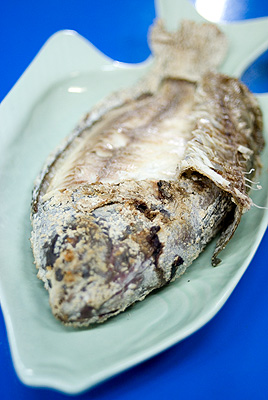
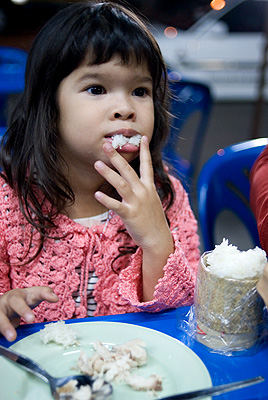
 technorati tags:
technorati tags: 